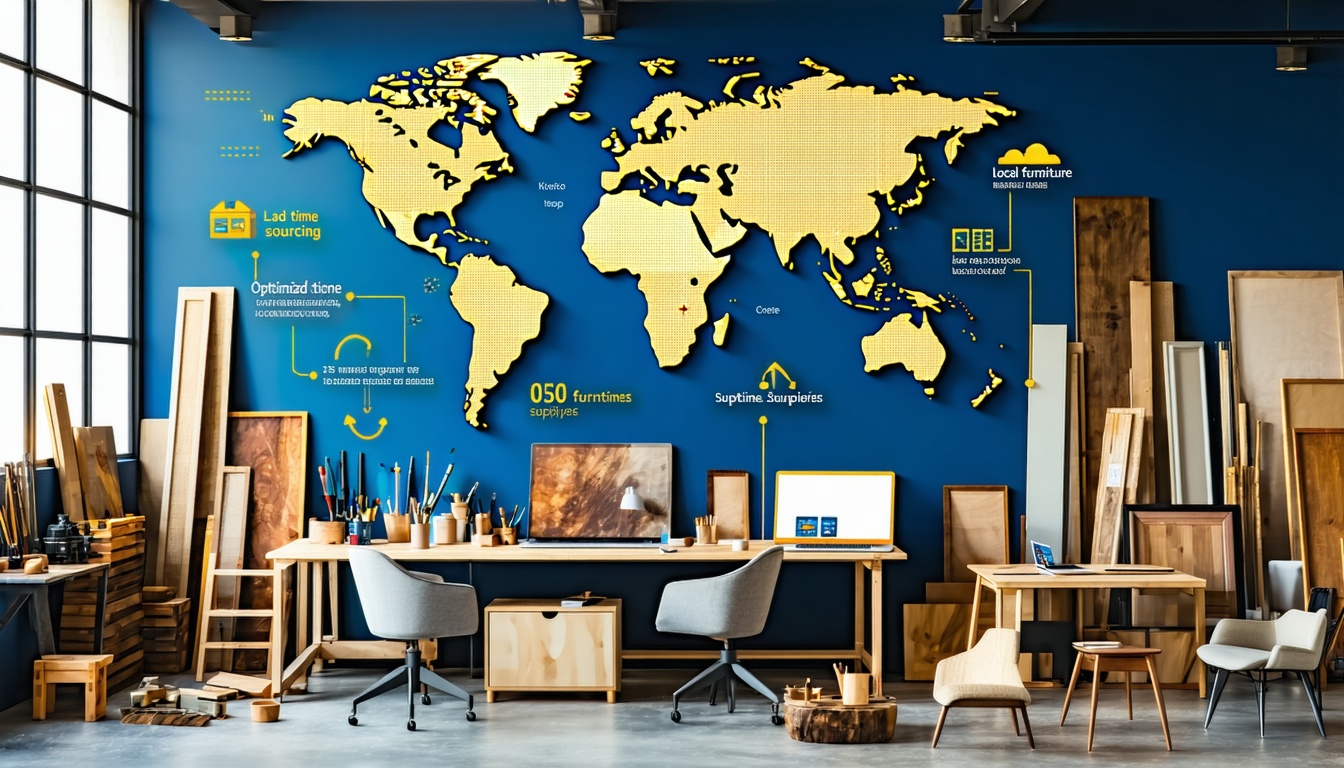Optimizing Production Processes
Boosting efficiency in production is a game-changer for furniture companies looking to cut down waiting times. It not only speeds things up but also cranks up product quality while keeping up with the growing appetite for planet-friendly practices.
Workspace Redesign Impact
Tinkering with how a workspace is laid out can make a big difference. By reshuffling the setup in a furniture factory, companies can save workers from unnecessary long walks and shuffles. This bump in efficiency not only trims down production times but also makes the most of the materials at hand.
Take this recent example where a furniture company revamped its layout, bringing stations closer to each other. This simple move shaved off production time remarkably, getting orders to customers quicker than before.
| Workspace Redesign Features | Impact on Production Time |
|---|---|
| Closer workstations | Cut travel time by 15% |
| Smoothed workflow | Sped up assembly by 20% |
| Better ergonomics | Workers 10% more efficient |
These changes aren’t just about saving time—they’re also about saving cash, which is crucial for keeping furniture shipments on track. For more tactics on fine-tuning your supply chain, check out our piece on furniture supply chain optimization strategies.
Task and Resource Organization
Nailing how tasks and resources are managed is another piece of the puzzle in slashing lead times for furniture makers. By sorting out which tasks come first and where resources should go, production gets a real kick forward.
Borrowing a page from the car industry, where tweaking task organization shrank lags between stages, furniture folks can see similar wins by applying the same logic.
| Task Optimization Techniques | Benefits |
|---|---|
| Clear task assignments | Cuts down on mix-ups and delays |
| Smart resource plans | Stops time wastage, boosts output |
| Training across tasks | Makes workforces more adaptable and productive |
Meanwhile, methods like Six Sigma can spot and nix kinks in the system to bump quality. For more on shrinking waiting times, see what’s covered in furniture manufacturing lead time reduction and reducing lead times in furniture logistics.
Putting these plans into action not only answers consumer demands but also lines up with rules about going green and sourcing sustainably. The push for constant improvement and efficiency also nudges the furniture world closer to its broader goals.
Enhancing Supply Chain Efficiency
Streamlining logistics in the furniture biz ain’t just about moving stuff from A to B; it’s about supercharging the whole setup. For this, two strategies stand out loud and clear. Meet your new friends: giving old supply contracts a makeover and getting your raw materials in line.
Supply Contract Makeovers
Sprucing up your supply contracts can seriously chop those waiting times. Take a look at this textile joint that tweaked its supplier agreements and—boom—costs went down and quality stayed up. Secure cooler deals, bulk buys, and delivery perks in an industry where waiting times can really grind your gears.
| Factors | Before Makeover | After Makeover |
|---|---|---|
| Cost per Board Foot | $4.00 | $3.50 |
| Average Wait Time (Days) | 30 | 20 |
| Quality Score (1-10) | 7 | 8 |
So, next time you’re out to zing up your supply chain mojo, dive deep into market research. Get to know what makes suppliers tick and lock in terms that match your game plan. Tighten those supplier bonds, and you’ll be firing on all cylinders with punctual deliveries and satisfied customers.
Raw Material Management
Material costs in the furniture game ain’t small fries—they can eat up 40% to 60% of what you spend to make stuff, with prices between $2.00 and $5.00 per board foot. That’s why managing your materials well is a smart move toward cash-saving and eco-friendliness.
Priority should go to snagging top-notch, green materials like reclaimed wood. It’s not only easier on the wallet but scores big with customers who care about saving the planet.
| Raw Material Type | Price per Board Foot | Eco-Get it? |
|---|---|---|
| Awesome Wood | $5.00 | Yep |
| Reclaimed Wood | $3.00 | Yep |
| Basic Wood | $2.00 | Nope |
Cranking out a solid material plan means taking a hard look at what’s already being used, scouting new options, and buddying up with local suppliers. Pull that off, and you’ll see steadier delivery times, less waste, and a perfect fit for the green goods market.
If you’re on the hunt for more tips to turbocharge your furniture supply logistics, eyeball our write-ups on furniture supply chain optimization strategies and cutting lead times in furniture logistics.
Tech’s Role in Speeding Things Up
Cutting down the time it takes to get furniture built and out the door? Sounds tricky, right? But tech’s got us covered. Companies looking to smooth out their supply chains gotta tap into stuff like automation, the Internet of Things (IoT), and blockchain.
What Automation and IoT Bring to the Table
When it comes to shaking up how companies deal with their supply chains, automation and IoT are the new dynamite. Pumping up technology with Vendor Managed Inventory (VMI) and Electronic Data Interchange (EDI) helps suppliers dance around the bumps in the road. These tech buddies dish out real-time inventory updates, shoot over restock suggestions, and make talking back and forth easy-as-pie, speeding things up along the way.
Sticking IoT gadgets on shipments lets firms snoop on location, weather, and traffic. They can then dodge delivery holdups by switching routes on the fly. Thanks to real-time tracking, companies can keep shipments safe, sidestepping misplaced stock or lost items.
| Tech Type | What You Get Out of It |
|---|---|
| VMI | Keeps you clued-in on inventory, jump-starts responses |
| EDI | Simplifies talk and automates data moving |
| IoT Devices | Keeps tabs on location, weather, and road conditions |
Folks in the biz predict that robots merged with AI and IoT smarts could handle as much as 65% of warehouse work soon—pumping up accuracy and getting stuff moving quicker. These human-and-cobot tag teams might slash work orders in half by next year. Automated warehouses could be the secret sauce in cutting time for getting furniture made.
Trust Your Stuff with Blockchain
Blockchain ain’t just buzzwords—it’s gold for cutting lead times in supply chains. By laying down unchangeable transaction records, it lets folks track where goods started and builds confidence among all players. This is super handy against cheat artists, catching fake items, and showing you follow the rules.
By tapping into blockchain, teams can see everything clearly, helping suppliers and distributors make better calls. With this visibility, they can dodge disruptions and keep the chain moving smoothly.
| Blockchain Perks | What’s It Good For |
|---|---|
| Solid Proof | Tracks the origins of products |
| Fraud Busting | Sniffs out fake stuff |
| Rule-Compliance | Shows you’re playing by the book |
Rolling these technologies into logistics helps firms cut times and tick off boxes for eco-friendly and ethical practices that customers have been banging on about. Companies aimed at slicing logistics times through local methods can take on these tech helpers to boost efficiency and go green.
Sustainable Practices for Local Sourcing
Chasing faster delivery times in the furniture biz? Companies today are keen on using eco-friendly methods for sourcing locally. It’s all about keeping up with customer expectations for green materials and following the rules. Two big moves here include using reclaimed wood and trying out circular production styles.
Reclaimed Wood Sourcing
Grabbing wood from old spots like barns or closed factories is the name of the game with reclaimed wood. It’s a fantastic way to skip cutting down more trees, helping both the environment and your costs. In the furniture scene, grabbing quality reclaimed wood matters a lot since raw stuff can suck up 40% to 60% of what you spend making that comfy sofa or sturdy table.
Why go reclaimed? Here’s the scoop:
| Benefit | What’s Cool About It |
|---|---|
| Environmentally Friendly | Less tree-chopping, more waste-busting. |
| One-of-a-Kind Look | Each piece of wood has its own tale and style, adding charm to furniture. |
| Cheaper Bill | Fewer bucks spent on new stuff, plus lower trash throwing costs. |
This wood style catches the eye of planet-loving shoppers and gives your brand a thumbs up.
Circular Production Models
Circular production models are all about using stuff wisely without chucking it too soon. Think of making furniture that’s a breeze to take apart and fix, along with recycling coolness. Why not let folks bring back old pieces for a fresh coat or a total redo?
By moving in this circle, businesses can score these wins:
| Win | What’s Great About It |
|---|---|
| Less Trash | Keeps junk out of dumps, saving resources. |
| More Savings | Spend less on new raw materials by reusing old stuff. |
| Loyal Customers | Shows you’re serious about saving the planet, pulling in all the green-minded folks. |
Bringing in gear like 3D printers mean making cool stuff near home, reducing delivery time, and cutting costs of freighting things around. It’s a nifty way to shrink that carbon footprint and sidestep the headaches from making stuff overseas.
For more tips on fast and clever ways to move furniture around, have a peek at our articles on furniture supply chain optimization strategies and reducing lead times in furniture logistics.

